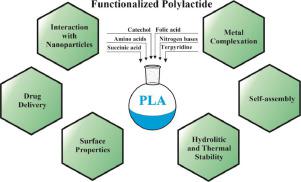Progress in Polymer Science ( IF 27.1 ) Pub Date : 2022-05-08 , DOI: 10.1016/j.progpolymsci.2022.101556 Bartłomiej Kost 1 , Malgorzata Basko 1 , Melania Bednarek 1 , Marta Socka 1 , Bartosz Kopka 1 , Grzegorz Łapienis 1 , Tadeusz Biela 1 , Przemysław Kubisa 1 , Marek Brzeziński 1

|
Polylactide (PLA) is one of the most important polymer and is used for the production of biodegradable materials. High-molecular-weight PLA is applied mainly for the manufacture of disposable consumer goods. In contrast, lower- or medium-molecular-weight polymers usually find applications in medicine for controlled drug release systems or implants. Most importantly, the properties of low- and medium-molecular-weight PLAs are strongly dependent on the nature of the end group. To adequately address this issue, this review summarizes the various structures of PLA end groups as well as the methods of their modification and characterization. The appropriate functionalization of PLA macromolecules is extremely important since it allows control of hydrolytic and thermal degradation, PLA self-assembly, and their interactions with nanosized particles or metal ions. In addition, the drug release from PLA-based particles can be adjusted by end group modification. The improved end-use properties of PLA-based materials by chain-end functionalization are desirable for their applications as drug delivery systems, tissue engineering, and electronic sensors. Therefore, the advantages and limitations of PLA end group modification are discussed. Special attention is given to the preparation of supramolecular PLA materials with the ability to respond to even mild environmental alteration or to undergo self-healing. Finally, an outlook regarding establishing the influence of PLA end groups on the properties of PLA-based materials is presented, and perspectives of this emerging area are discussed.
中文翻译:

官能端基对聚乳酸基材料性能的影响
聚乳酸(PLA)是最重要的聚合物之一,用于生产可生物降解的材料。高分子聚乳酸主要用于制造一次性消费品。相比之下,低分子量或中等分子量的聚合物通常在药物中用于控制药物释放系统或植入物。最重要的是,低分子量和中分子量 PLA 的性质在很大程度上取决于端基的性质。为了充分解决这个问题,本综述总结了 PLA 端基的各种结构以及它们的修饰和表征方法。PLA 大分子的适当功能化非常重要,因为它可以控制水解和热降解、PLA 自组装、以及它们与纳米粒子或金属离子的相互作用。此外,基于 PLA 的颗粒的药物释放可以通过端基修饰来调节。通过链端功能化改善基于 PLA 的材料的最终用途性能对于它们作为药物输送系统、组织工程和电子传感器的应用是可取的。因此,讨论了PLA端基修饰的优点和局限性。特别注意制备能够响应甚至轻微的环境变化或进行自我修复的超分子PLA材料。最后,展望了建立 PLA 端基对 PLA 基材料性能的影响,并讨论了这一新兴领域的前景。PLA基颗粒的药物释放可以通过端基修饰来调节。通过链端功能化改善基于 PLA 的材料的最终用途性能对于它们作为药物输送系统、组织工程和电子传感器的应用是可取的。因此,讨论了PLA端基修饰的优点和局限性。特别注意制备能够响应甚至轻微的环境变化或进行自我修复的超分子PLA材料。最后,展望了建立 PLA 端基对 PLA 基材料性能的影响,并讨论了这一新兴领域的前景。PLA基颗粒的药物释放可以通过端基修饰来调节。通过链端功能化改善基于 PLA 的材料的最终用途性能对于它们作为药物输送系统、组织工程和电子传感器的应用是可取的。因此,讨论了PLA端基修饰的优点和局限性。特别注意制备能够响应甚至轻微的环境变化或进行自我修复的超分子PLA材料。最后,展望了建立 PLA 端基对 PLA 基材料性能的影响,并讨论了这一新兴领域的前景。通过链端功能化改善基于 PLA 的材料的最终用途性能对于它们作为药物输送系统、组织工程和电子传感器的应用是可取的。因此,讨论了PLA端基修饰的优点和局限性。特别注意制备能够响应甚至轻微的环境变化或进行自我修复的超分子PLA材料。最后,展望了建立 PLA 端基对 PLA 基材料性能的影响,并讨论了这一新兴领域的前景。通过链端功能化改善基于 PLA 的材料的最终用途性能对于它们作为药物输送系统、组织工程和电子传感器的应用是可取的。因此,讨论了PLA端基修饰的优点和局限性。特别注意制备能够响应甚至轻微的环境变化或进行自我修复的超分子PLA材料。最后,展望了建立 PLA 端基对 PLA 基材料性能的影响,并讨论了这一新兴领域的前景。特别注意制备能够响应甚至轻微的环境变化或进行自我修复的超分子PLA材料。最后,展望了建立 PLA 端基对 PLA 基材料性能的影响,并讨论了这一新兴领域的前景。特别注意制备能够响应甚至轻微的环境变化或进行自我修复的超分子PLA材料。最后,展望了建立 PLA 端基对 PLA 基材料性能的影响,并讨论了这一新兴领域的前景。


























 京公网安备 11010802027423号
京公网安备 11010802027423号